Data Structures in Python
1/29
There's no tags or description
Looks like no tags are added yet.
Name | Mastery | Learn | Test | Matching | Spaced |
|---|
No study sessions yet.
30 Terms
Pros to Complex Types being included Natively
Convenient, as you don’t have to implement the data structure or operations yourself
Can lead to short and elegant solutions (parsimonious)
Can lead to powerful programming paradigms (e.g. list based languages, functional programming paradigms)
Cons to Complex Types being included Natively
Harder to understand performance underlying operations
Generic implementations are rarely efficient for all tasks (data dependent)
Can be harder to control run time behaviour (especially with respect to memory use or bounded resources)
Python Data Types
Lists - Ordered, mutable, allows duplicate elements. Useful for sequences of data
Tuples - Ordered, immutable, allows duplicate elements. Effectively immutable lists
Sets - Unordered, mutable, contains unique elements. Useful for testing membership and eliminating duplicates from e.g. lists
Dictionaries - Unordered, mutable, mapped by key-value pairs. Key-value pairs (think hash-table, where we look up the value for a given ‘key’)
Does Order Matter?
Sometimes:
Every time we examine the queue the relative order of elements is preserved
LIFO (queue) and FIFO (stack), and other ADTs (trees, heaps,…) order matters!
For others, the internals are more opaque
Tuples
marked by () parentheses, and may have 0 or more values
variables are mutable, and can be changed
the structure itself is not mutable, you can’t update it’s value
accessing the first value in the structure using array subscript notation

Lists
denoted by [], and are mutable
can address the list as an array
can update/assign values to a list
![<ul><li><p>denoted by [], and are mutable</p></li><li><p>can address the list as an array</p></li><li><p>can update/assign values to a list</p></li></ul><p></p>](https://knowt-user-attachments.s3.amazonaws.com/948bfb92-d42b-4295-8bae-419dbdb19b8c.png)
Data Types in Python are Objects
have built in methods
includes .append() a value, .extend() with another list
can pop() values from it, insert() values within it
the list is ordered, so we can build a queue or a stack, and even .sort() it
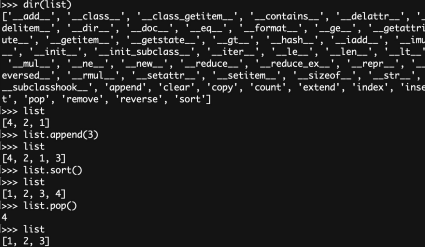
Data Structures Can do ‘Arithmetic’
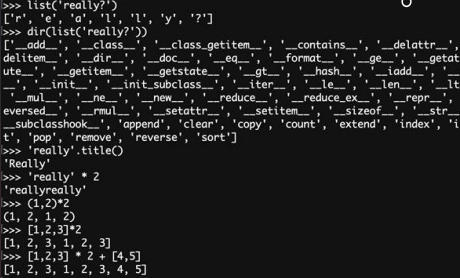
Sets
Mutable, but unordered
We can’t add sets, but we can union them! (with |)
We can |= just like we can +=
We can test if an element is in a set
The order is not preserved, but uniqueness is

Elements
Can be any type, types can be nested
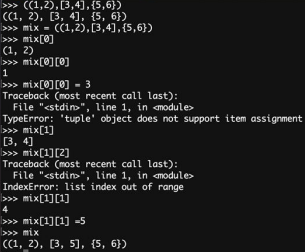
Name Value Pairs
Very useful
myDict = {'Adrian': 'is old', 'Saad': 'is young'}
Creates a dictionary with two keys ‘Adrian’, and ‘Saad’
Keys and values are both strings in this case
myDict[‘Adrian’] returns ‘is old’
myDict[‘Joe’] throws a KeyError
![<p>Very useful</p><p>myDict = {'Adrian': 'is old', 'Saad': 'is young'}</p><ul><li><p><span>Creates a dictionary with two keys ‘Adrian’, and ‘Saad’</span></p></li><li><p><span>Keys and values are both strings in this case</span></p></li><li><p><span>myDict[‘Adrian’] returns ‘is old’</span></p></li><li><p><span>myDict[‘Joe’] throws a KeyError</span></p></li></ul><p></p>](https://knowt-user-attachments.s3.amazonaws.com/16a1c461-4047-4d41-84b0-2ac818620a9a.png)
Functions
an entire data structure
def get_lecturers():
return {'Adrian' : 18, 'Saad' : 21}a nested data structure
def get_lectures():
return [('Adrian', 18), ('Saad', 21)]something inside a data structure
def get_age(name):
return {'Adrian' : 18, 'Saad', 21}[name]multiple values
def get_details():
return 'Adrian', 18Assignment
we can assign multiple variables
can pack and unpack data structures into and from variables
the number of variables corresponds to the number of elements we wish to unpack
Multiple Assignment
name, age = 'Saad', 21Packing
x = 'Adrian', 18Unpacking
name, age = xIterators
iter gets the iterator from an iterable
next gets the next element, if it can
finishes with ‘StopIteration’

Using a Loop for Iteration
call the iterator for us
can iterate through a data structure using ‘for’
for lists, sets and tuples this returns each element
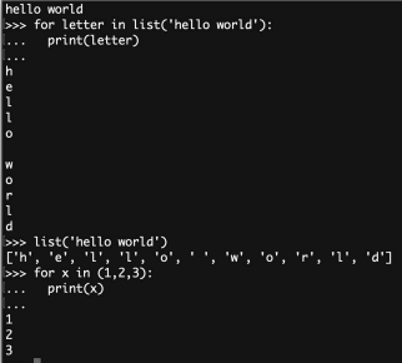
Unpacking in Loops
can unpack a dictionary as (key, value) tuples
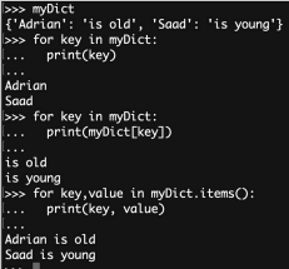
filter(function, iterable)
selects items from an iterable that satisfy a condition
input - a function that returns T/F, an iterable
output - iterator with only the items where function returns true
filter Example with Regular Function
grades = [50, 55, 45, 62, 30, 75]
def has_passed(grade):
return grade >= 50
passed = list(filter(has_passed, grades))
#[50, 55, 62, 75]filter Example with Lambda Function
grades = [50, 55, 45, 62, 30, 75]
passed = list(filter(lambda grade: grade >= 50, grades))
#[50, 55, 62, 75]Lambda Function
lambda arguments : expression
small anonymous function
can take any number of arguments, but only one expression
map (function, iterable)
transforms each item in an iterable using a function
input - function to execute for each item and return new item, iterable
output - iterator with transformed items
map Example with Regular Function
passed = [50, 55, 62, 75]
def add_bonus(grade):
return grade + 5
updated = list(map(add_bonus, passed))
#[55, 60, 67, 80]map Example with Lambda Function
passed = [50, 55, 62, 75]
updated = list(map(lambda grade: grade + 5, passed))
#OR
updated = [grade + 5 for grade in passed]
#[55, 60, 67, 80]reduce (function, iterable[, initialiser])
reduces the iterable to a single value by applying the function cumulatively
input - function that takes 2 arguments and performs an operation on them, iterable, optional initialiser as a starting value for the operation
output - single value
reduce Example with Regular Function
numbers = [1, 2, 3, 4, 5]
def add(x, y)
return x + y
reduced = reduce(add, numbers)
#15reduce Example with Lambda Function
numbers = [1, 2, 3, 4, 5]
reduced = reduce(lambda x, y: x + y, numbers)
#15reduce Example with Operator Library Function
numbers = [1, 2, 3, 4, 5]
from operator import add
reduced = reduce(add, numbers)
#15